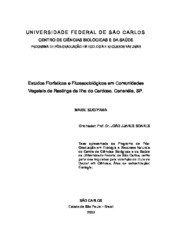| dc.contributor.author | Sugiyama, Marie | |
| dc.date.accessioned | 2016-06-02T19:29:51Z | |
| dc.date.available | 2005-01-17 | |
| dc.date.available | 2016-06-02T19:29:51Z | |
| dc.date.issued | 2003-05-27 | |
| dc.identifier.citation | SUGIYAMA, Marie. Estudos florísticos e fitossociológicos em comunidades vegetais de restinga da Ilha do Cardoso, Cananéia, SP.. 2003. 141 f. Tese (Doutorado em Ciências Biológicas) - Universidade Federal de São Carlos, São Carlos, 2003. | por |
| dc.identifier.uri | https://repositorio.ufscar.br/handle/ufscar/1778 | |
| dc.description.abstract | The present study evolved floristic composition, structure and regeneration dynamic
aspects of a restinga forest (pluvial sand coastal plain forest), at Ilha do Cardoso, in
Cananéia region, São Paulo State, Brazil. Three portions of restinga forest with
same physiognomic aspects were selected: restinga of Trilha para o Morro das
Almas (MA), Trilha Interpretativa (TI) and Estrada para a Captação (EC). Five
strata of forest were sampled in each portion: Tree, Tree/shrub, Shrub/herbaceous,
Herbaceous and Lianas. Each portion was analyzed individually and subsequently
were analyzed the entirely of the three portions and compared them. At Trilha para
o Morro das Almas were sampled 73 species, at Trilha Interpretativa 72, at
Estrada para a Captação 56 and totally sample 112, inside them 31 species were
common to three portions and 46 restrict only one of them. The three portions of a
forest were floristically similar, MA and TI had the highest Sørensen similarity
(70,3%), and TI and EC had the less Sørensen similarity (55,5%). When compared
the strata in general Tree/shrub and Shrub/herbaceous strata had the highest value
of Sørensen similarity, and the Tree and Herbaceous strata had the less similarity.
The highest diversity and equability were found in herbaceous strata, and the less in
tree strata. The plants of the three portions had majority of species with geographic
distribution in south and southeast Brazil regions, and the majority individuals and
species were secondary-climax category. The portions of studied forest were in
advanced stage of regeneration, and shade-tolerant species were favored. The
differences between three portions of a forest were due to natural process common
in tropical forests, where the substitution of one tree produce a mosaic of distinct
regenerative phases at community that differ in structure and floristic composition.
Differences in environment physical conditions, especially edaphic factors, and
distinct anthropic interventions are responsible too. | eng |
| dc.format | application/pdf | por |
| dc.language | por | por |
| dc.publisher | Universidade Federal de São Carlos | por |
| dc.rights | Acesso Aberto | por |
| dc.subject | Ecologia florestal | por |
| dc.subject | Florística | por |
| dc.subject | Estrutura de comunidades | por |
| dc.subject | Dinâmica de vegetação | por |
| dc.subject | Floresta de restinga | por |
| dc.subject | Restinga forest | eng |
| dc.subject | Floristic composition | eng |
| dc.subject | Geographic distribution | eng |
| dc.subject | Forest structure | eng |
| dc.subject | Forest diversity | eng |
| dc.subject | Forest strata | eng |
| dc.subject | Forest regeneration | eng |
| dc.subject | Succession dynamic
Brazil | eng |
| dc.title | Estudos florísticos e fitossociológicos em comunidades vegetais de restinga da Ilha do Cardoso, Cananéia, SP. | por |
| dc.type | Tese | por |
| dc.contributor.advisor1 | Soares, João Juares | |
| dc.contributor.advisor1Lattes | http://genos.cnpq.br:12010/dwlattes/owa/prc_imp_cv_int?f_cod=K4781112H7 | por |
| dc.description.resumo | O presente estudo envolveu a composição florística, a estrutura e aspectos da
dinâmica de regeneração de floresta de restinga (floresta pluvial da planície
arenosa costeira), na Ilha do Cardoso, Cananéia, Estado de São Paulo, Brasil.
Foram selecionadas três áreas com fisionomias semelhantes: restinga da Trilha
para o Morro das Almas (MA), da Trilha Interpretativa (TI) e da Estrada para a
Captação (EC). Foram amostrados cinco estratos em cada uma delas: Arbóreo,
Arbóreo/arbustivo, Arbustivo/herbáceo, Herbáceo e Lianas. Cada uma das áreas foi
analisada individualmente e posteriormente fez-se uma análise conjunta
comparando as três áreas entre si. Na Trilha para o Morro das Almas foram
amostradas 73 espécies, na Trilha Interpretativa 72, na Estrada para a Captação 56
e na amostragem total 112, sendo que 31 espécies foram comuns às três áreas e
46 foram restritas à apenas uma delas. Pelo índice de Sørensen as três áreas são
floristicamente similares entre si, sendo que MA e TI apresentaram a maior
similaridade (70,3%) e TI e EC a menor similaridade (55,5%). Na comparação entre
os estratos de modo geral entre o arbóreo/arbustivo e o Arbustivo/herbáceo houve
maior similaridade de Sørensen e, entre o Arbóreo e o Herbáceo menor. A maior
diversidade florística e equabilidade couberam ao estrato herbáceo e as menores
ao arbóreo. Nas três áreas amostradas a maioria das espécies apresentaram
padrão de distribuição geográfica sul e sudeste do Brasil e, a maioria dos indivíduos
e das espécies pertencia à categoria sucessional secundária tardia. Os trechos de
floresta estudados estão em estágio avançado da sucessão e as espécies
tolerantes à sombra estão sendo favorecidas. As diferenças entre os três trechos
da floresta amostrados devem-se a processos naturais comuns nas florestas
tropicais, onde a substituição de árvores produz um mosaico de distintas fases
regenerativas na comunidade que diferem na estrutura e na composição floristica.
As diferenças nas condições físicas ambientais, especialmente fatores edáficos e,
as intervenções antrópicas diferenciadas também são responsáveis por essas
diferenças. | por |
| dc.publisher.country | BR | por |
| dc.publisher.initials | UFSCar | por |
| dc.publisher.program | Programa de Pós-Graduação em Ecologia e Recursos Naturais - PPGERN | por |
| dc.subject.cnpq | CIENCIAS BIOLOGICAS::ECOLOGIA | por |
| dc.contributor.authorlattes | http://buscatextual.cnpq.br/buscatextual/visualizacv.do?id=K4789658Z7 | por |
